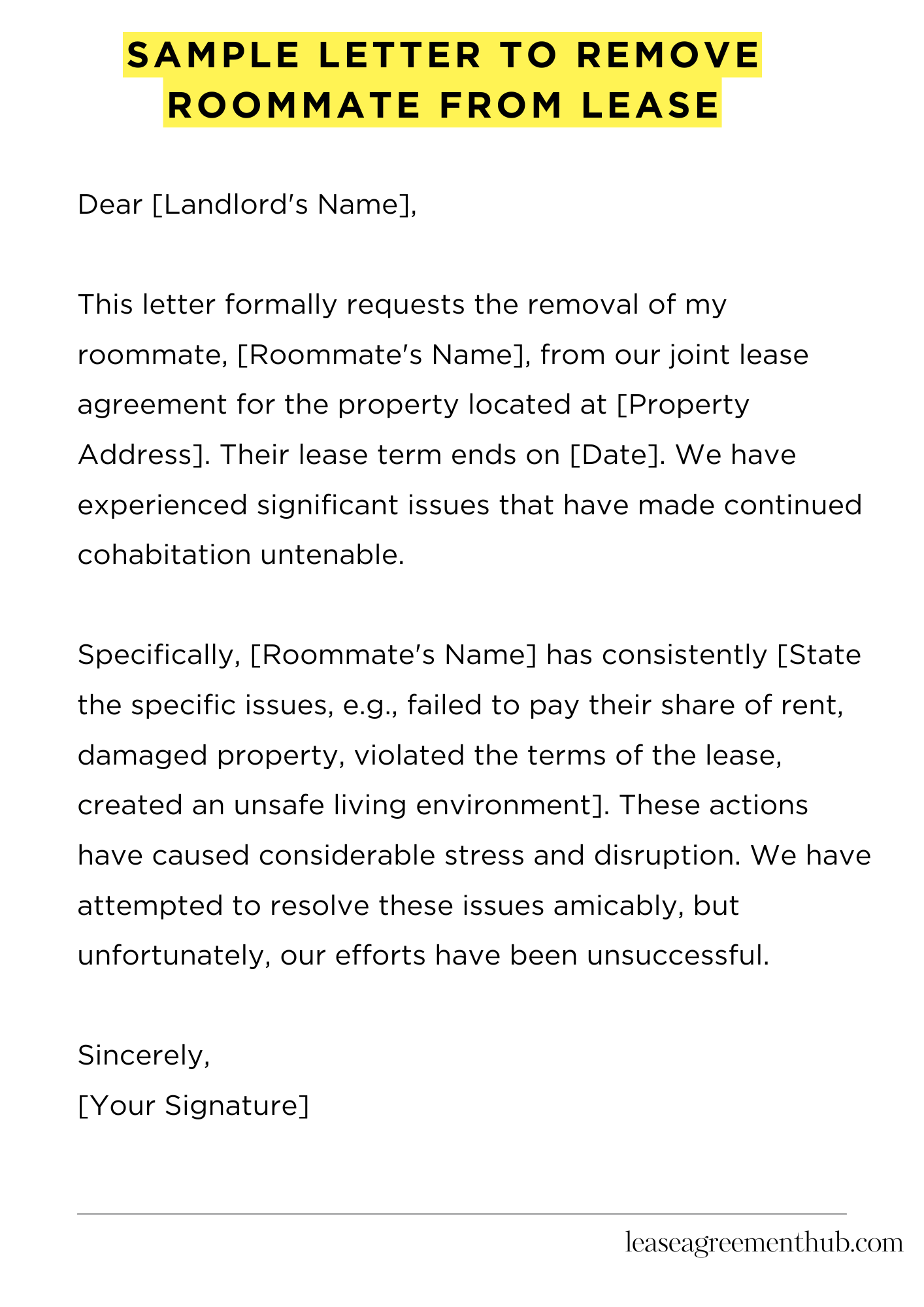Are you looking to remove a roommate from your lease? A sample letter to remove roommate from lease can help you with this process.
In this article, we will provide you with templates and examples of sample letters to remove a roommate from a lease. These samples will make it easier for you to draft your own letter.
Whether you need to remove a roommate due to non-payment of rent, violation of lease terms, or simply because you no longer want to live with them, our sample letters will guide you through the process.
Sample Letter to Remove Roommate from Lease
[Your Name]
[Your Address]
[Your Phone Number]
[Your Email Address]
[Date]
[Landlord’s Name]
[Landlord’s Address]
Dear [Landlord’s Name],
This letter formally requests the removal of my roommate, [Roommate’s Name], from our joint lease agreement for the property located at [Property Address]. Their lease term ends on [Date]. We have experienced significant issues that have made continued cohabitation untenable.
Specifically, [Roommate’s Name] has consistently [State the specific issues, e.g., failed to pay their share of rent, damaged property, violated the terms of the lease, created an unsafe living environment]. These actions have caused considerable stress and disruption. We have attempted to resolve these issues amicably, but unfortunately, our efforts have been unsuccessful.
I am prepared to continue residing at the property and fulfill all obligations under the lease agreement. I request that you process this request promptly and inform me of the necessary steps to finalize the removal of [Roommate’s Name] from the lease. I am available to discuss this matter further at your convenience.
Sincerely,
[Your Signature]

How to Write a Sample Letter to Remove Roommate from Lease
Understanding the Legal Ramifications
Before drafting your missive, thoroughly understand your lease agreement. Its clauses regarding roommate removal are paramount. Ignoring these could jeopardize your legal standing. Consult legal counsel if ambiguities exist. Clarity is crucial in this legally precarious situation.
Gathering Essential Information
Accurately record all pertinent details. This includes the lease’s termination date, the complete legal names of all parties involved, and the specific address of the property. Omitting even seemingly insignificant information could weaken your case. Meticulous record-keeping is essential.
Crafting a Formal and Concise Letter
Adopt a formal tone, eschewing any emotive language. Directness is key. State your intention explicitly: to remove your roommate from the lease. Provide a clear and concise rationale. Avoid hyperbole; stick to verifiable facts. A well-structured letter demonstrates seriousness of purpose.
Detailing the Grounds for Removal
Articulate the reasons for seeking your roommate’s removal with specificity. Did they violate the lease agreement? Did they engage in egregious behavior? Substantiate your claims with irrefutable evidence, such as photographs, witness statements, or police reports if applicable. Remember, unsubstantiated claims are easily dismissed.
Presenting a Proposed Solution
Suggest a practical resolution. Perhaps you’ll cover their portion of the rent until a replacement tenant is found. Alternatively, you might propose a buyout of their remaining lease obligation. Showing a willingness to compromise strengthens your position and demonstrates good faith.
Sending the Letter via Certified Mail
Send your letter via certified mail with return receipt requested. This provides irrefutable proof of delivery, protecting you against claims of non-receipt. It serves as documented evidence of your attempt to resolve the issue amicably before escalating the matter. This is a crucial step.
Seeking Legal Counsel (When Necessary)
If your initial attempt fails to yield a positive outcome, consult with a legal professional. They can advise you on the next steps and represent your interests if the matter proceeds to litigation. Don’t hesitate to seek expert guidance if the situation becomes intractable. Remember prevention is better than cure.
FAQs about sample letter to remove roommate from lease
How do I legally remove a roommate from a lease?
The legal process for removing a roommate from a lease varies depending on your lease agreement and local laws. Generally, it involves providing formal written notice to both your roommate and your landlord, outlining the reasons for the removal and requesting the landlord to amend the lease agreement. Legal counsel may be necessary to ensure compliance with all applicable regulations.
What should I include in a letter to remove a roommate from a lease?
A letter requesting the removal of a roommate should clearly state your intention, the reasons for the request (e.g., breach of lease terms, safety concerns, irreconcilable differences), and the desired outcome (removal of the roommate from the lease). It should be professional, factual, and avoid emotional language. Include dates, relevant details, and keep a copy for your records.
What if my roommate refuses to leave after receiving the letter?
If your roommate refuses to vacate the premises after receiving the letter, you may need to consult with an attorney or seek legal advice. Depending on your lease and local laws, you may have to pursue eviction proceedings through the court system.
Is it necessary to involve the landlord in the process of removing a roommate?
Yes, it’s crucial to involve the landlord. The landlord is a party to the lease agreement and must approve any changes, including removing a tenant. Ignoring the landlord could lead to complications and potential legal issues for you.
Can I remove a roommate without their consent?
Removing a roommate without their consent is generally difficult and requires a valid legal reason, such as a breach of the lease agreement (e.g., non-payment of rent, damage to property, violation of lease terms). You should consult with an attorney to determine the legality and best course of action in your specific situation.
Related: